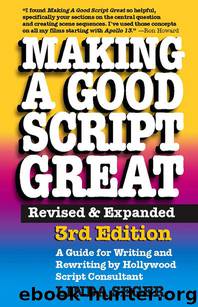Making a Good Script Great by Seger Linda

Author:Seger, Linda [Seger, Linda]
Language: eng
Format: epub, azw3
ISBN: 9781935247012
Publisher: Silman-James Press
Published: 2013-12-01T05:00:00+00:00
CHAPTER SEVEN
Creating a
Cohesive Script
Whether listening to a piece of music, looking at a painting, or watching a movie, we tend to want an experience that feels unified and cohesive. Different art forms attain cohesiveness in different ways. Music tends to use recurring motifs, rhythms, and harmonies to set up expectations that will be either thwarted (for tension) or fulfilled (for repose). Through repetition it builds tension and expectation and simply lets us know that we’re still listening to the same piece. A single instrument might thread its way throughout a piece, playing many variations on a melody, or the sound of one instrument might be used to contrast with the sound of another.
In painting, cohesion may derive from a color or shape or texture that may repeat itself across a single canvas or throughout a series of paintings. And a painting’s contrasts and repetitions of elements may direct our eyes in very specific ways across and around a canvas. Architecture achieves cohesiveness through repeated and contrasting patterns of windows, arches, and two-and three-dimensional shapes, and through the use of light.
A film gains cohesiveness through the use of foreshadowing (and payoff), recurring motifs, repetition, and contrast.
Foreshadowing
In film, foreshadowing is the use of visual or audio material (an object or image or word or sound or piece of dialogue) to hint at and build the audience’s expectations for specific future events. All of us have watched murder mysteries in which the camera zooms in on a letter opener that is later used as a murder weapon (a benign object is now ominous). This is an obvious use of foreshadowing and payoff.
We often see foreshadowing and payoff in mysteries in which the audience needs help following a series of complex clues. We also see it in comedies, where jokes need to be set up (drop a banana peel on the sidewalk and…).
Near the beginning of the Star Wars trilogy, significant information is given about Luke Skywalker’s father. This information is paid off later when we discover that his father is Darth Vader.
In Act One of Pirates of the Caribbean: Curse of the Black Pearl, Elizabeth Swann invokes the Right of Parlay, asking for the pirates to follow their own code of conduct. Later, Jack Sparrow invokes Parlay as well. What was set up in Elizabeth’s scene is paid off in Jack’s scene. In this same film, it’s mentioned that Barbossa left Jack on an island with a pistol but only one shot (foreshadow). Later in the story, that one shot is used (payoff).
In Pulp Fiction, Vincent’s frequent trips to the bathroom are set up, and then paid off when he’s there rather than in the restaurant, when the robbery takes place.
Some good foreshadowings and payoffs are found in Back to the Future.
DR. BROWN
If my calculations are correct, when this car hits 88 miles an hour, you’re gonna see some serious shit.
And it works just as he says it will. At 88 miles per hour.
Sometimes foreshadowing works cleverly when an object or piece of information is set up in one context and paid off in another.
Download
This site does not store any files on its server. We only index and link to content provided by other sites. Please contact the content providers to delete copyright contents if any and email us, we'll remove relevant links or contents immediately.
| Dance | Individual Directors |
| Magic & Illusion | Reference |
| Theater |
Call Me by Your Name by André Aciman(20437)
Ready Player One by Cline Ernest(14586)
How to Be a Bawse: A Guide to Conquering Life by Lilly Singh(7438)
Wiseguy by Nicholas Pileggi(5711)
The Kite Runner by Khaled Hosseini(5134)
On Writing A Memoir of the Craft by Stephen King(4893)
Audition by Ryu Murakami(4891)
The Crown by Robert Lacey(4764)
Call me by your name by Andre Aciman(4648)
Gerald's Game by Stephen King(4612)
Harry Potter and the Cursed Child: The Journey by Harry Potter Theatrical Productions(4468)
Dialogue by Robert McKee(4354)
The Perils of Being Moderately Famous by Soha Ali Khan(4194)
Dynamic Alignment Through Imagery by Eric Franklin(4179)
Apollo 8 by Jeffrey Kluger(3672)
Seriously... I'm Kidding by Ellen DeGeneres(3607)
The Inner Game of Tennis by W. Timothy Gallwey(3604)
How to be Champion: My Autobiography by Sarah Millican(3571)
Darker by E L James(3493)
